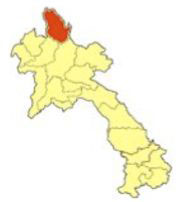The Nammatay School Project
The school was completed in the fall of 2010. Opportunity for All's Al O'Connor and Anne Studabaker visited the school in November 2010 to take part in the official handover ceremony where the school was presented to the village. Some of the photos taken on that trip are below. You can read more about the details of the visit here.

The New School - November, 2010!

The students lined up to greet us as we arrived for the school's dedication ceremony.

Al presents a gift of book for the school's library at the dedication ceremony.
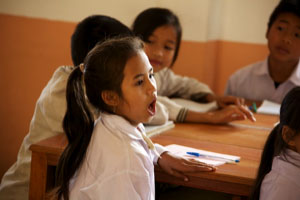
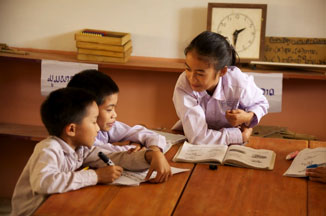
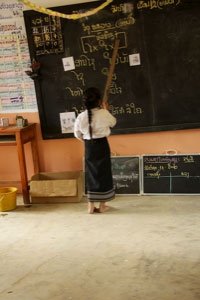

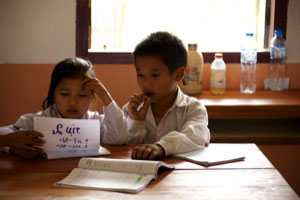

Background for the Nammatay School Project
Opportunity for All and Room to Read Laos partnered with the Nammatay Complete Primary School Construction Committee and the Students’ Guardian Association to build a six-room school building. The new building is made of brick, cement and reinforced concrete, and has a concrete slab floor, a sheet-metal roof, and a wood ceiling in each room. The rooms measure 6m x 7m. Five rooms are used as classrooms and one room is used as a library. A separate, two-room toilet was built adjacent to the school.
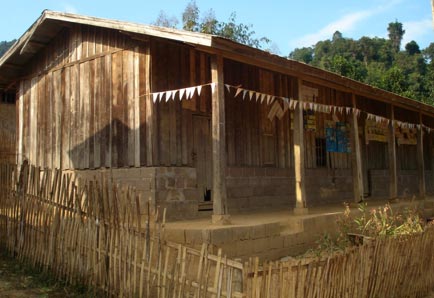
The Existing School
Community Profile
Nammatay Village is located in the mountains of northern Laos on the road that leads to Vietnam. Travel in this area is convenient in the dry season but is very difficult during the rainy season due to landslides. This village has 112 households representing a population of 421. The main ethnic group living here is the Thai Dam. The principal economic activities include farming, especially the planting of sugar cane and rice. The weather is generally good all year round, with a cold winter from December to March (lowest temperatures are near zero Celsius) followed by a dry season from April to May. The rainy season lasts from June to October. Houses are built primarily in the Thai Dam style and are made of wood, bamboo and concrete. The village has a gravity feed-water system and toilets, but lacks electricity.
The Ho Chi Minh trail, part of which runs through Laos, was a major target for American bombs during the Vietnam War. As a result, many provinces in Laos were heavily bombed and/or covered with landmines. Phongsaly Province was less affected by the Vietnam War than some other provinces in Laos, but a certificate from the government certifying that all unexploded ordnance (UXO) has been removed from the area is still required for all construction sites.
The Ho Chi Minh trail, part of which runs through Laos, was a major target for American bombs during the Vietnam War. As a result, many provinces in Laos were heavily bombed and/or covered with landmines. Phongsaly Province was less affected by the Vietnam War than some other provinces in Laos, but a certificate from the government certifying that all unexploded ordnance (UXO) has been removed from the area is still required for all construction sites.
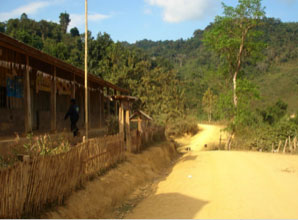
The site for the new school
The Former School
Nammatay Village had a complete primary school that offers grades 1 - 5 and serves pupils from five villages. This school has one building with three classrooms. The roof is made of corrugated sheet metal that is very old and leaks when it rains. The walls, made of wood and bamboo, are badly decayed and the dirt floors contribute to an uncomfortable learning environment. The school overall is in very poor condition. It has no library or library materials, inadequate supplies of educational materials, and is poorly funded. These insufficiencies decrease the opportunity for children to receive a quality education and negatively impact their ability to develop adequate knowledge.
This school was originally funded and built by the villagers themselves. Every year the villagers use their limited funds to maintain the current building but they do not have the resources needed to construct a proper school for their children. In the past, the government has supported this school by providing teachers and some textbooks, but school construction and maintenance were left to the community. The new school will replace the old structure and will add more classrooms plus a library.
This school was originally funded and built by the villagers themselves. Every year the villagers use their limited funds to maintain the current building but they do not have the resources needed to construct a proper school for their children. In the past, the government has supported this school by providing teachers and some textbooks, but school construction and maintenance were left to the community. The new school will replace the old structure and will add more classrooms plus a library.
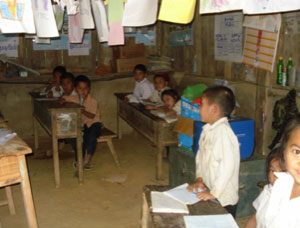
One of the old classrooms
Community Contribution to the Project
- Volunteer labor for all unskilled work required by the project
- Wood for the roof structure and ceiling frame
- Backfill soil as needed for the foundation
- Security during the construction period
- Official certification of UXO clearance
- Legal title for land belonging to the school
- A source of water for the new school building
- Work with local education authorities to ensure teachers are available for the school
- Monitoring of materials purchasing to ensure quality, quantity, and transparency
- Community contribution of 22% of the total project cost
